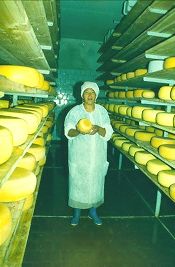 Conservation of biodiversity is not possible without participation of the local people. The project executed a number of RRA’s (Rapid Rural Appraisal) in the buffer zone, during which the buffer zone population was interviewed about the presence of HNP and its impact on their livelihoods. The larger majority of the responses was positive to very positive as to the presence of HNP. But it was also regretted that access to the pastures of HNP was no longer open, especially so since the degradation around the park has become apparent as a result of immigration from herdsmen from the West of Mongolia. The results of these studies have been integrated in the buffer zone management plan on which the project document for the Buffer Zone Project was based. Conservation of biodiversity is not possible without participation of the local people. The project executed a number of RRA’s (Rapid Rural Appraisal) in the buffer zone, during which the buffer zone population was interviewed about the presence of HNP and its impact on their livelihoods. The larger majority of the responses was positive to very positive as to the presence of HNP. But it was also regretted that access to the pastures of HNP was no longer open, especially so since the degradation around the park has become apparent as a result of immigration from herdsmen from the West of Mongolia. The results of these studies have been integrated in the buffer zone management plan on which the project document for the Buffer Zone Project was based.
Participation of the local herdsmen have been achieved by engaging them in the project and making sure that they did not feel chased off or neglected. Activities funded from the Park can be divided in three categories: |
- Public awareness activities: These include organised visits to the Park like an annual week-end for local herdsmen families and for children, contacting local herdsmen on the objectives and regulations of the Park, handing out of brochures, and organising small exhibitions on the Park and its wildlife in the surrounding villages. A classroom in the schools is furnished with small exhibitions on the takhi and the park. Video equipment could be bought for showing nature conservation films.
- Compensation for lost assets after the declaration of the Hustain Nuruu Park. These are activities of a collective nature such as: the improvement of the public health situation; renovation of bridges of the Tuul river, assistance to schools (renovation, etc.) and renovation of the central heating system in the villages; improvement of livestock keeping through rehabilitation of wells, animal health improvement (establishing cattle dips, etc,) and provision of pedigree animals.
 Economic development activities. Examples include: the establishment of the cheese-factory in Altanbulag; the yoghurt factory in Bayanhankhai; support to farmers of Argalant and Bayanhankhai; promotion of hay-making and -selling; but also training of women in small scale commercial activities and a small credit fund. Last but not least the Park provides for jobs. All rangers and wardens belong to the local community. Small scale tourism in the buffer zone is stimulated and local guides participate in the guide training at HNP. The law on buffer zones has been adopted in the Great Khural in 1997. In according with this law three Buffer Zone Committees have been established, one in each village. These three are associated in a Buffer Zone Council for HNP. In each Buffer Zone Committee are represented the local governments, local herdsmen, women, HNP and MACNE, 7 persons in total. The Buffer Zone Council meets minimum twice a year to discuss urgent issues, concerning development of the buffer zone and make decisions. Each Buffer Zone Committee has its own Buffer Zone Development Fund. The chairman of the Buffer Zone Council is member of the Hustai National Park Trust board and represents the Council within the board.
Economic development activities. Examples include: the establishment of the cheese-factory in Altanbulag; the yoghurt factory in Bayanhankhai; support to farmers of Argalant and Bayanhankhai; promotion of hay-making and -selling; but also training of women in small scale commercial activities and a small credit fund. Last but not least the Park provides for jobs. All rangers and wardens belong to the local community. Small scale tourism in the buffer zone is stimulated and local guides participate in the guide training at HNP. The law on buffer zones has been adopted in the Great Khural in 1997. In according with this law three Buffer Zone Committees have been established, one in each village. These three are associated in a Buffer Zone Council for HNP. In each Buffer Zone Committee are represented the local governments, local herdsmen, women, HNP and MACNE, 7 persons in total. The Buffer Zone Council meets minimum twice a year to discuss urgent issues, concerning development of the buffer zone and make decisions. Each Buffer Zone Committee has its own Buffer Zone Development Fund. The chairman of the Buffer Zone Council is member of the Hustai National Park Trust board and represents the Council within the board.
Under leadership of the Mongolian park staff and the Buffer Zone Council the herders community has organised itself in more than 25 herdsmen collectives. They make appointments with each other about the use of summer and winter pastures for their live stock, assist each other in many activities, discuss the quality of pastures and cooperate in trainings. The Buffer Zone Project stimulates alternative means of income generation, like community based tourism. A credit program has been developed with financial assistance of the Dutch government. This is tremendous popular. In this way low rent loans can be used controlled by the Buffer Zone Council. Many training sessions have been executed for livestock improvement, processing and marketing of agricultural products like traditional felt-making and others.
